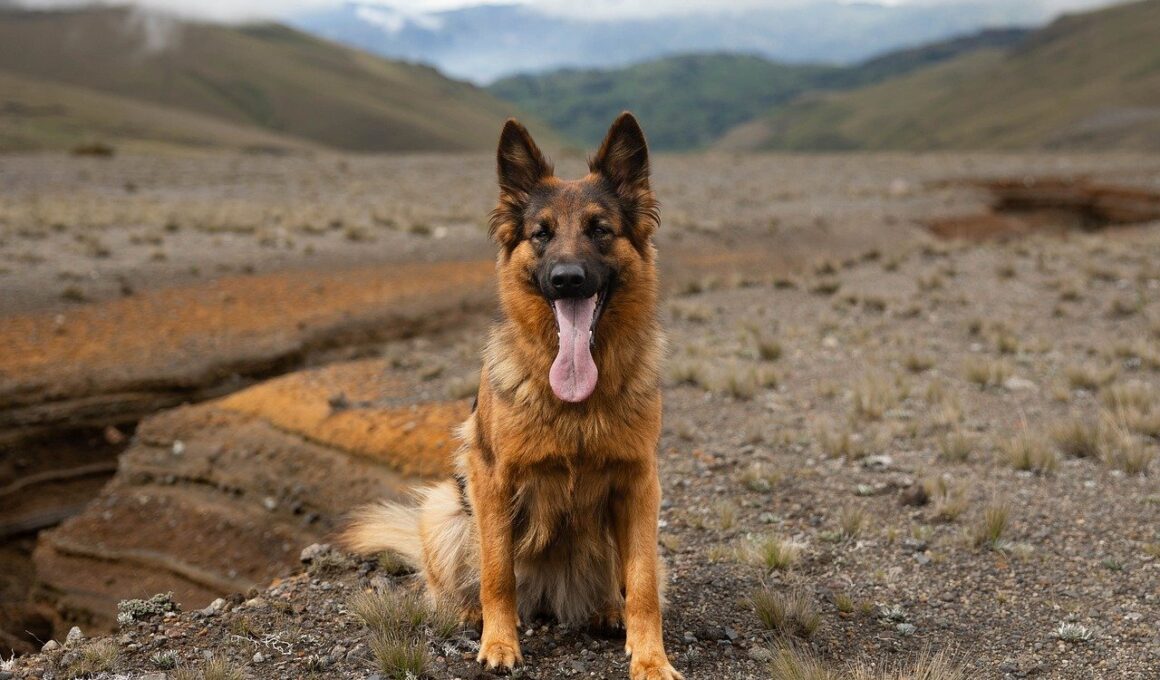Preparing Your Dog for High Altitude Mountain Travel
Many dog owners are excited to take their furry companions on mountain adventures, but preparation is essential for a safe trip. High altitude travel can present challenges for dogs just as it does for people. To ensure a smooth experience, it’s crucial to get your dog acclimated to elevated environments gradually. Start with short hikes at higher elevations before tackling significant trails. Pay careful attention to your pet’s behavior during these initial outings. Monitor for excessive panting, fatigue, or disorientation. These symptoms often indicate that your dog may be struggling with altitude changes. It’s also a good idea to consult your veterinarian prior to your journey. Make sure your dog is in good health and discuss any potential concerns related to altitude. Preparing your dog with physical conditioning is essential for endurance while hiking. Incorporate regular exercise and short hikes into your dog’s routine. Lastly, consider carrying a dog backpack with essential supplies. This will help meet both your pet’s needs and ensure you are all set for any journey. This preparation will create an enjoyable experience for both you and your canine friend on those breathtaking mountain trails.
Hydration is critical when traveling to high altitudes with your dog. As you ascend, the air becomes drier, increasing your dog’s chances of dehydration. Always carry ample water for both you and your pet. Consider bringing a collapsible water bowl, making it easy to provide your dog with quick access to hydration as needed. Monitor your dog for signs of dehydration, such as excessive panting, dry gums, or lethargy. If you notice these symptoms, stop immediately, offer water, and allow for rest. It’s also wise to plan your route around water sources, when possible. Look for lakes or streams that offer a safe place for your dog to drink and cool off. Some owners may worry about water quality. To alleviate this, portable water filters can offer a solution for purifying water from natural sources. Don’t forget to hydrate yourself as well, since you’ll be exerting yourself along with your furry friend. Staying hydrated helps maintain energy levels and stamina for enjoyable hiking. Always take adequate breaks to drink water for both of you while trekking. The right preparation regarding hydration will keep your dog fresh and ready to tackle the mountain with you.
Nutrition During High Altitude Adventures
Nutrition plays an essential role in maintaining your dog’s energy level while high in the mountains. Be conscious of their dietary needs and ensure you bring enough food for the entire trip. It’s recommended to pack a high-quality, energy-dense dog food designed to support an active lifestyle. Consider bringing meal portions in easy-to-carry containers for convenience. Adjust their feeding schedule to match your hiking pace and activity levels. If you plan on engaging in prolonged hikes, include healthy snacks that can be fed throughout the day. Lightweight treats that offer nutritional benefits can provide necessary energy boosts. Some dog-friendly options include peanut butter-filled snacks or dehydrated meat bits. Be mindful to keep food storage secure from wildlife, as your dog’s meals may attract unwanted guests. Always clean up any food residues after meals to avoid leaving traces behind. Monitoring your dog’s food intake is essential to prevent overeating in a new environment. Tailor their food intake based on activity levels and elevation. Proper nutrition will maintain your dog’s stamina and overall health during your mountain travels, enabling enjoyable explorations together.
First aid for dogs is crucial in case of injuries or health issues while hiking in the mountains. Make an emergency first aid kit that has essential items, like bandages, antiseptics, and gauze. A snake bite kit might be necessary, depending on the area’s wildlife. Make sure to stock up on any medications your dog takes regularly. Familiarize yourself with basic first aid techniques specific to dogs to be prepared for any situation. Carry copies of your dog’s health records, including details about vaccinations and medications. This information can be valuable during emergencies, especially in more remote areas. Create a plan for injuries, including rest locations where your dog can recuperate. Identify these spots in advance based on your route choice. Furthermore, inform your hiking companions about your dog’s needs and how to assist in emergencies. It is crucial to remain calm and use your judgment to assess when professional veterinary help is required. Being prepared for emergencies minimizes risks during high altitude hikes and ensures your pet remains safe. Taking these precautions creates a safer hiking experience and strengthens the bond with your dog.
Clothing and Gear for Your Dog
Weather conditions can change rapidly in mountainous areas, so equip your dog with suitable clothing and gear. Consider weather-resistant jackets for cooler temperatures and rain-resistant options for wet conditions. This will keep your dog warm and dry, ensuring their comfort on long trails. Additionally, booties can protect your dog’s paws from rough terrain, hot surfaces, and snow. When selecting dog gear, prioritize breathability and a snug fit to avoid potential injuries. Keep in mind that your dog should adjust to wearing new equipment before the hiking trip. Introduce items like harnesses or jackets at home, allowing your dog to get used to them. Ensure your dog is comfortable by rewarding them with positive reinforcement while they try on these items. Always carry your dog’s identification, including a tag with your contact info. In case of any separation, this can help reunite you with your dog quickly. An ID should be attached to your dog’s collar, or consider an embedded microchip as an alternative. The right clothing and gear will enhance your dog’s experience while keeping them safe from harsh mountain elements.
Fitness and conditioning are fundamental before embarking on mountain treks with your dog. Improving your dog’s physical stamina will enhance their overall experience. Implement a training schedule that includes a variety of exercises such as long walks, jogging sessions, or even agility training. These activities can help build endurance and move to specific training for mountain hiking. Start with shorter hilly walks to gradually prepare your dog for elevated trails, and be consistent in this training. It’s essential to recognize your dog’s limits; overworking them could lead to exhaustion or injury. Monitor your pet’s energy levels and adjust your training accordingly. Besides physical fitness, ensure your dog is mentally stimulated by engaging in brain games or obedience routines. This preparation not only aids physical health but also enhances bonding between you and your pet. When you both work together to accomplish training tasks, it fosters trust and reliance essential in high-adventure settings. A well-conditioned dog is better equipped to handle the challenges of mountain travel comfortably, making the journey enjoyable for both of you.
Gradual Acclimatization Technique for Dogs
Gradual acclimatization is a vital factor in preparing your dog for a high-altitude environment. Sudden elevation changes can overwhelm them, leading to potential health issues. Start by introducing your dog to higher elevations gradually to allow their body to adapt. Plan multiple short trips at progressively higher altitudes. This technique helps gauge your dog’s response to the changes and allows you to monitor their adjustment. During these preliminary trips, observe how your dog acts in higher elevations. Their reactions can provide insight into how they may handle future adventures. In case of any concerning symptoms like excessive panting or loss of energy, turn back to lower elevations and ensure they rest. Allow your dog to familiarize themselves with new smells, sights, and sounds typical at higher altitudes during these practice outings. The goal is to ensure that their body adjusts without undue stress. Always prioritize safety during this acclimatization process as your dog experiences its surroundings. Utilizing gradual acclimatization techniques promotes a more enjoyable and successful hiking experience, leading to fond memories together.
In conclusion, traveling to high altitudes with your dog can be rewarding when proper preparations are in place. Establish a solid routine of conditioning, nutrition, hydration, and essential gear to support your furry friend’s comfort and safety during hikes. The journey can leave lasting memories if you prioritize their well-being and observe their responsive behaviors. Each step of preparation reinforces your bond, ensuring both of you are ready to embrace the challenges of altitude. Always remember that the health of your dog is paramount, and monitor their adjustment meticulously. Take the necessary precautions to prepare your dog for every aspect of their adventure, from first aid kits to safe hydration practices. As adventure-lover owners, the responsibility falls on you to remain vigilant and informed. With a well-thought-out plan, the mountains can become a beautiful playground for exploration and companionship. Cherish these moments together as they forge deeper connections between you and your dog. Through knowledge and care, high-altitude travel with your furry friend can be a delightful experience full of unique sights and cherished moments.


